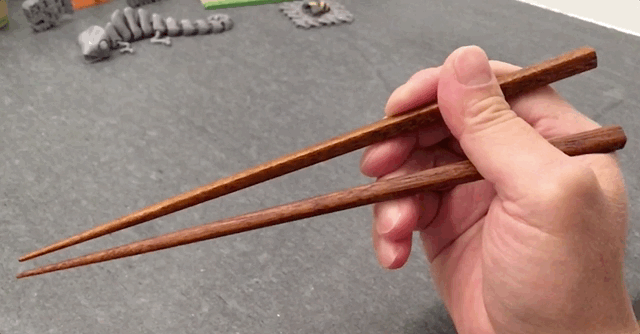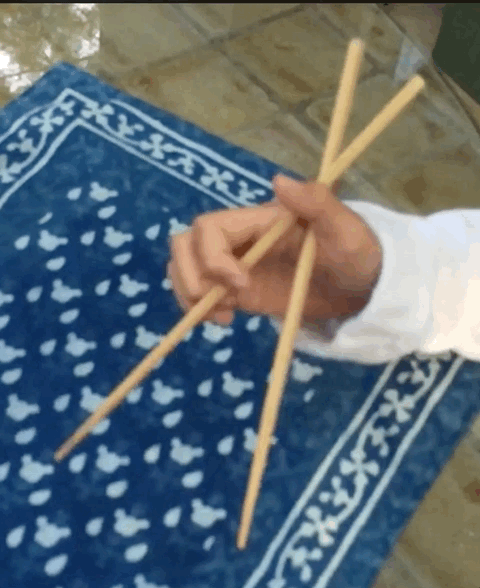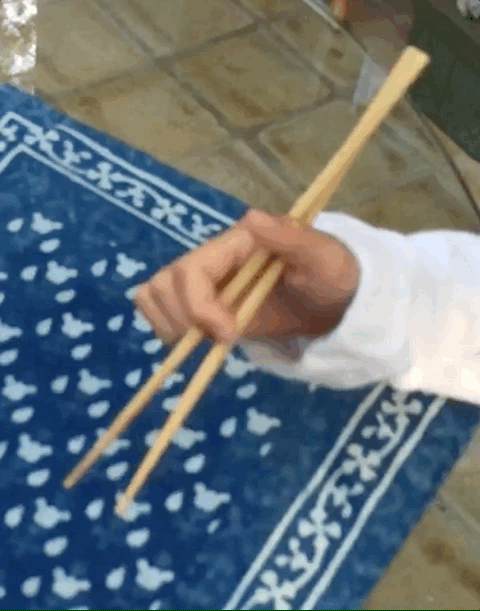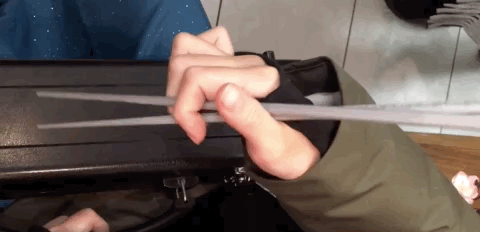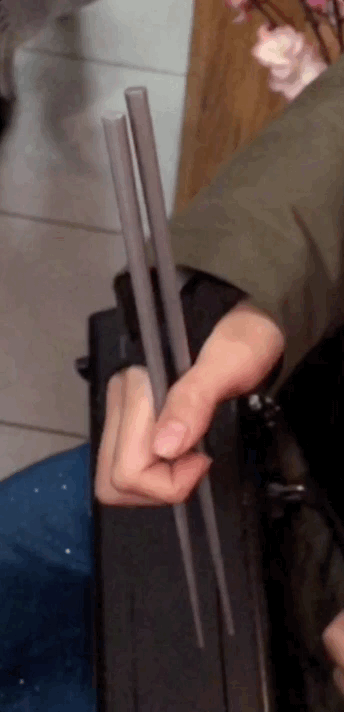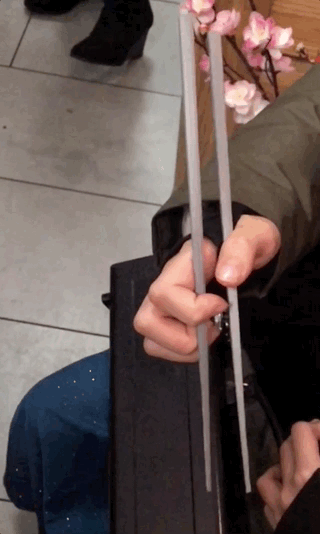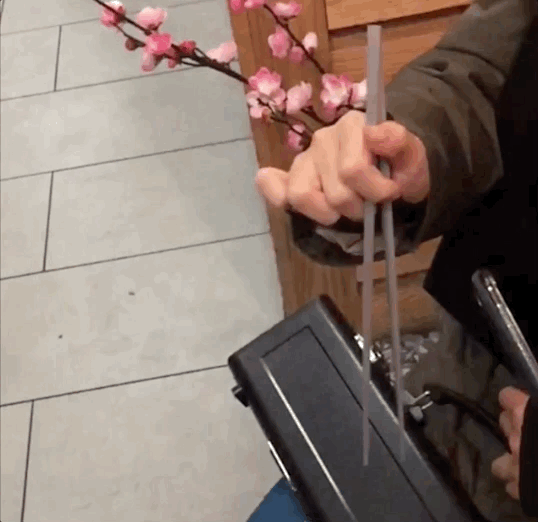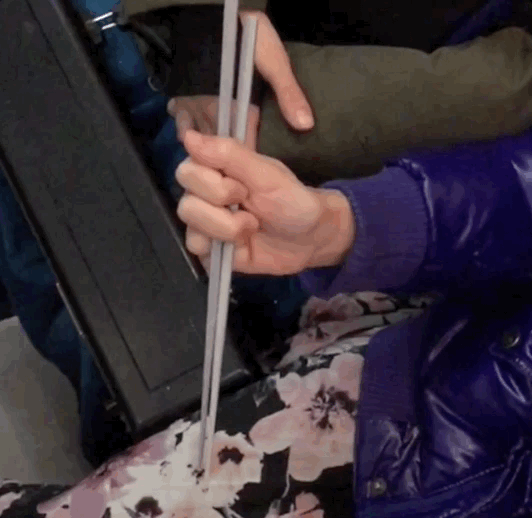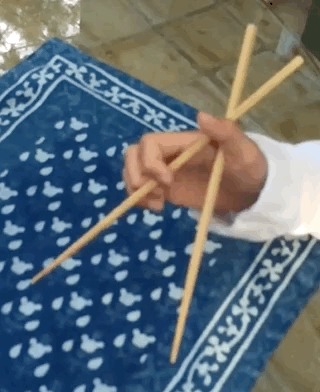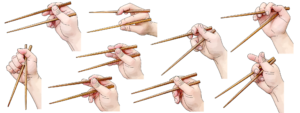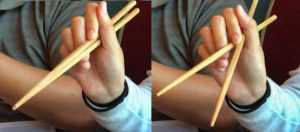Last Updated on July 15, 2022 by Staff
The article image succinctly illustrates the Dangling Stick grip. Throughout the alternating motion of extending and closing tips of chopsticks, the bottom chopstick dangles almost freely, held onto by only the base of the thumb against the purlicue.
Table of Contents
Dangling Stick vs. Chicken Claws
Images below highlight the relationship of Dangling Stick to its parent, the Chicken Claws grip. A key characteristic that Dangling Stick inherits from Chicken Claws is the blatant disregard for the proper use of the tip segment of the thumb. Only the base of the thumb is used when closing tips of chopsticks. Another feature Dangling Stick preserves from Chicken Claws is the caging of the top chopstick between the index finger and the middle finger. This is 2/3 of the tripod hold Chicken Claws inherits from the granddaddy of all alternative grips, the Standard Grip.
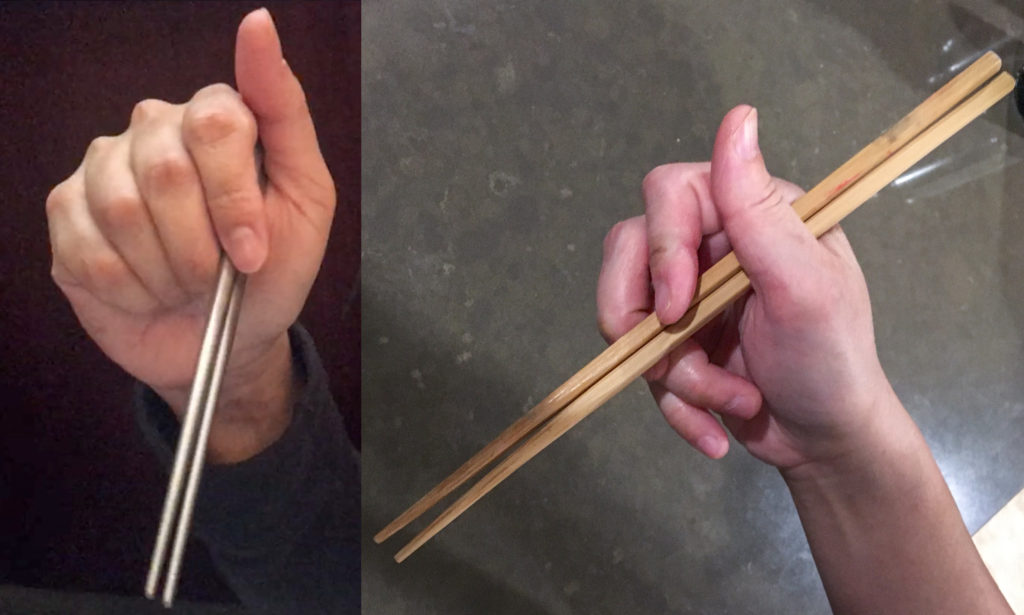
Dangling Stick deviates from Chicken Claws, in its treatment of the ring finger and the pinky. These two fingers serve no purpose in Dangling Stick. While the ring finger supports the bottom chopstick in Chicken Claws, it is relieved of all duties in Dangling Stick. This disregard for the ring finger can be confirmed both in the above illustration, and the below illustration. It may be hard to believe, staring at the open posture images below, that these two grip types are intimately related. But the truth is that a simple abdication of duty by the ring finger causes massive ramifications, resulting in drastic visual differences shown below.
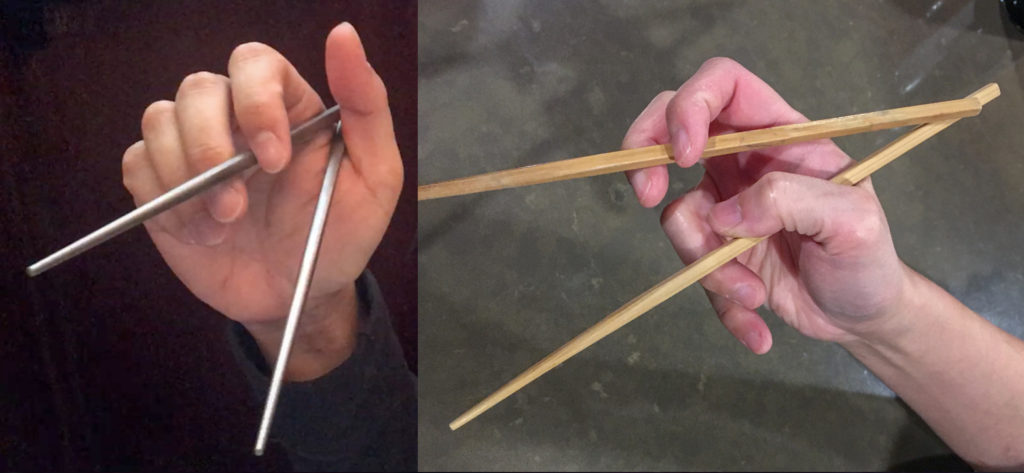
Purists of chopstick research will insist that Dangling Stick be classified and named as a Sideway Swing variant of Chicken Claws. But we are pragmatic, and also simple-minded. When we see a grip dangle the bottom stick, we name it that.
Gravity and the dangling bottom chopstick
Video shown below to the left is a recording of an alternative motion demonstrated by a user of the Dangling Stick grip. Compare it to the Standard Grip shown below on the right. Note how the bottom chopstick in Dangling Stick is allowed to freely drop down, when the user wishes to extend chopsticks apart. Using gravity is a key part of the Dangling Stick technique.
Sometimes the bottom chopstick is left dangling, while the user manipulates only the top chopstick. Here gravity assists with the stabilization of the bottom chopstick, as shown in slow-motion captures below. The air-snapping motion goes smoother on the left. The motion is hindered in the video shown to the right, because the user has not allowed for enough downward angle for the bottom chopstick to be stabilized by gravity.
Some alternative grips also make use of gravity. But each employs its own different way to leverage gravity. For instance, Cupped Vulcan uses gravity to help move the top stick, unlike Dangling Stick which moves the bottom stick instead. In any case, neither of these grips will work as efficiently in the International Space Station, compared to Earth.
Gravity and sideway movements
Below is a recording of Dangling Stick motion from top looking down. It shows that there is a sideway component to the alternating motion of this grip, in addition to vertical ups and downs. In this instance, the user again struggles with the motion, due to insufficient gravity assist.
Below is a slow-motion capture of the above.
Gravity-assisted vertical movements
The next two videos were shot from the side. The user shifted her hand posture to accommodate the shot. Now the bottom chopstick is pulled downward by gravity. The user is now able to swing the dangling chopstick with the base of the thumb, shown on the left. The video on the right demonstrates how the base of the thumb holds the bottom chopstick lightly against the purlicue, allowing the user to shake the stick using the purlicue as a pivot.
Manipulations of the top chopstick
The above video to the left hints at how a user of Dangling Stick manipulates the top chopstick. Both index finger and middle finger bend inward, forming the shape of a hook. These fingers remain in the hook shape throughout the alternating motion. Knuckles connecting fingers to the palm do most of the work. These flex and extend, thus moving the top chopstick which is sandwiched by two fingers. The following picture sequence illustrate this knuckle action.
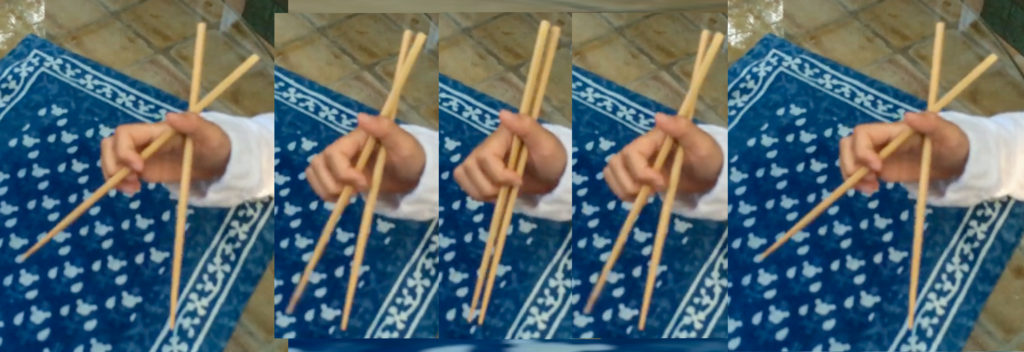
The manipulation of top chopstick is identical for both Dangling Stick and Chicken Claws.
Ring finger variation
The picture below to the left shows a user holding chopsticks at the mid section of the sticks. The picture below to the right shows chopsticks being held at the rear end. Other than the exact placement location along chopsticks, both pictures show the same Dangling Stick grip.
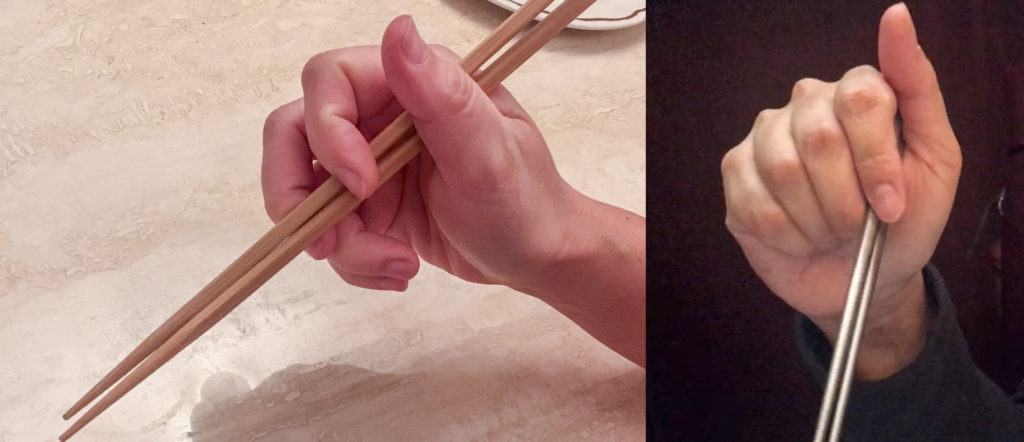
The picture below to the left illustrates a variation of Dangling Stick at the open posture. Unlike other open postures shown earlier, in this picture, the user checks the drop of the bottom chopstick with the knuckle of the ring finger. Compare this checked drop to the free drop of a typical Dangling Stick shown below to the right.
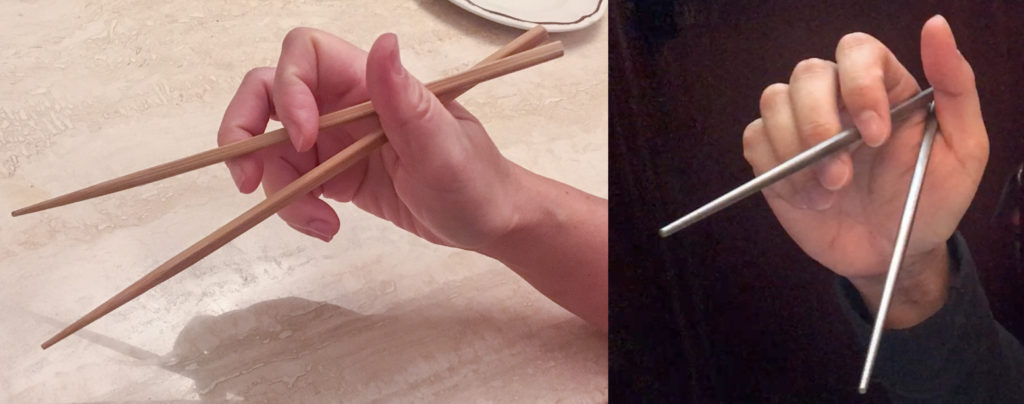
Non-functional crossed look
The two chopsticks shown below to the left appear crossed. This is caused by the mid-section placement of the hand along chopsticks. The crossed look is just an illusion. The crossing of sticks have no impacts on the actual function of chopsticks. If the rear ends of chopsticks on the left are nipped at the crossing point, the Dangling Stick grip will continue to work. In fact, it will then look like the picture below to the right.

For a detailed discussion of crossedness or rather, our dismissal of this visual look as a factor in differentiating types of alternative grips, please proceed to the article Out with the Crossed Type, In with the Under Swing.
Varied thumb placement
Similar to Chicken Claws, the placement of the thumb can be varied in Dangling Stick, at the closed posture, or when the hand is at ease. It doesn’t matter that the thumb is extended straight and pointing up in the picture below to the left. It doesn’t matter that the thumb is bent and lying on the top chopstick in the picture below to the right. Just like in Chicken Claws, the thumb is not performing any function in Dangling Stick. It doesn’t matter.
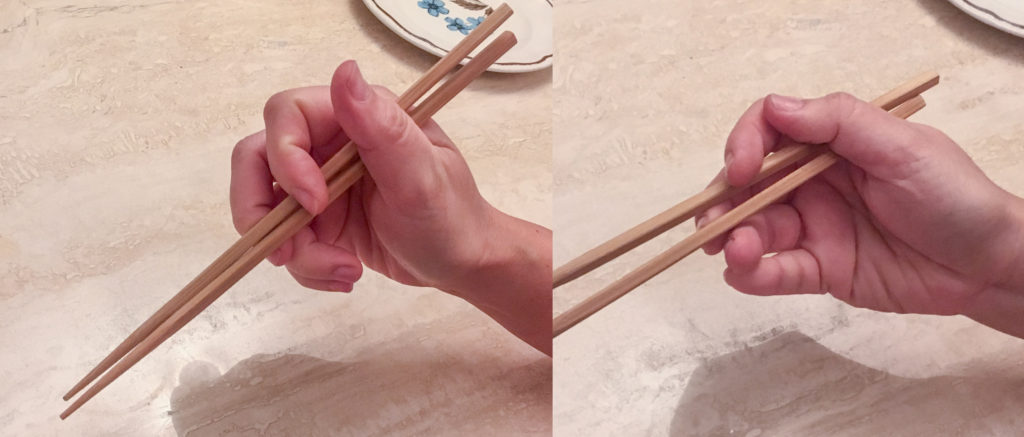
Dangling Stick vs. Dino Claws
Dangling Stick also shares many visual similarities with Dino Claws. This includes the sideway motion of sticks, as well as the “crossed” look of sticks, when a user holds chopsticks at the center instead of at the rear end. In addition, when asked to extend chopsticks really wide, this Dangling Stick user adopts almost the same technique as the Dino Claws user, shown below.
Weak compression force
Users of Dangling Stick face similar challenges as Dino Claws. Namely, this grip produces very little leverage for picking up food. While Dangling Stick appears to have a longer distance between the index finger and the purlicue for the top chopstick to apply force, the bottom chopstick is not able to provide equal counterforce to effectively hold food between tips. This is because the bottom chopstick is only held at one single point, by the base of the thumb against the purlicue. This single point is also the pivot of the bottom chopstick. Thus very little leverage is to be had.
Another reason is that this grip closes in on food items while the chopsticks form an outward extending angle, allowing food items to slip away. On the other hand, many other grips, such as the Standard Grip, close in on regular food items with an inward angle, effectively pinching said food items in place.
There is also the issue of “rear end collision” to consider. Dangling Stick relies on one specific configuration for the “crossed” rear ends. The rear of the top chopstick must swing past the rear of the bottom chopstick, from above, and not below. One such rear end collision is shown below, in the slow-motion capture to the left. Thus, the user must keep the rear end of the top stick above the bottom stick at all times, as shown below, in the slow-motion capture to the right.
Because of the lack of leverage, sometimes a user of Dangling Stick will turn to other alternative grips for help. In the following video, a Dangling Stick grip appears to turn into a Vulcan Grip mid-action, in order to securely pick up a food item. But in reality, it becomes Cupped Vulcan, a grip remarked for its downward-facing cupped hand.
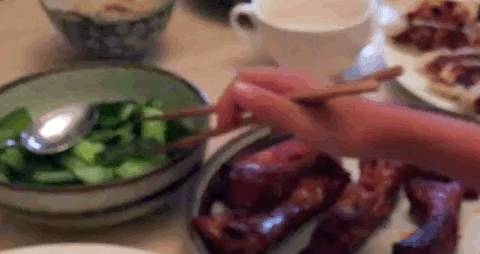
Additional videos from practitioners
Here is another practitioner demonstrating the Dangling Stick grip. In this clip, operation of the top chopstick by fingers is clearly observed.
Following is a clip played at normal speed, showing additional perspectives on the operation of Dangling Stick.
Following is the same clip as shown above, with interesting parts slowed down at various speed, including 10x slower. At the very end, there is a “catch a free-falling blueberry” challenge which only superheros can successful master.
Learn new grips
In summary, Dangling Stick inherits from its parent grip, Chicken Claws, the complete disuse of the pulp of the thumb. In addition, it relieves the ring finger of all duties involved in holding the bottom chopstick. The bottom chopstick is thus left dangling by the pivot point, held only by the base of the thumb and the purlicue.
Users of Dangling Stick may learn to twirl chopsticks with Standard Grip, thus increasing their leverage on food items. This can be done by mastering the 1-on-2-support technique for holding the bottom chopstick, and the tripod hold technique for manipulating the top chopstick. Wouldn’t it be cool to show off several ways to use chopsticks to your friends?
Taiwanese: 夾一支箸
This grip is known as 夾一支箸 (gia̍p chi̍t-ki tī, or gia̍p tsi̍t-ki tī) in Taiwanese. The name refers to the dangling chopstick being clamped in place between the rear end of the top chopstick and the purlicue.



